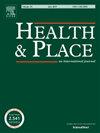历史红线对当今医院选址和规模的持续影响
IF 4.1
2区 医学
Q1 PUBLIC, ENVIRONMENTAL & OCCUPATIONAL HEALTH
引用次数: 0
摘要
背景:在医院护理的可及性、质量和结果方面,种族健康差异持续存在。这些差异在地理上是有规律的,但矛盾的是,靠近医院并不具有保护作用。历史上的政府政策,如划红线,可以解释这种悖论。20世纪30年代,房主贷款公司(Home Owners’Loan Corporation, HOLC)绘制了明确以种族为基础的地图,从而导致了20世纪下半叶黑人居民占很大比例的社区人口大量减少、财产贬值和政治权力被剥夺。第二次世界大战后,由于《希尔-伯顿法案》,医院的扩张可能利用了这些种族化的经济和政治梯度。我们的研究调查了历史上的HOLC红线类别是否与当今医院的位置和规模有关。方法使用2023年国土基础设施基金会级医院数据集中的医院位置和Mapping Inequality数据集中的位置和类别。我们根据每个居屋类别所占土地的比例,计算预期的医院数目及总病床数目。我们使用Pearson卡方检验比较医院和床位的观察计数。结果医院在HOLC D红色区域的代表性明显过高(20.5%),在HOLC A绿色区域的代表性明显不足(35.6%)。医院床位在D地区被高估了56.5%,在A地区被低估了44.7%,在B地区被低估了5.2%,在c地区被低估了20.8%。讨论我们表明,就20世纪30年代的HOLC类别而言,医院的位置在整个美国并不均匀分布。第二次世界大战后医院容量的扩大可能利用了剥削性政策。通过增加对社区福利的投资,医院有能力也有机会纠正过去的不公正现象,改善卫生公平。本文章由计算机程序翻译,如有差异,请以英文原文为准。
Persistent effects of historical redlining on present day hospital siting and size
Background
Racial health disparities persist in hospital care access, quality, and outcomes. These disparities are geographically patterned but paradoxically hospital proximity is not protective. Historical governmental policies such as redlining may explain this paradox. Redlining, proxied by explicitly race-based maps drawn by the Home Owners’ Loan Corporation (HOLC) in the 1930s, led to extensive depopulation, property devaluation, and political disempowerment in neighborhoods with significant proportions of Black residents in the latter half of the 20th centuries. Hospitals expanding in the post-World War II period due to the Hill-Burton Act may have taken advantage of these racialized economic and political gradients. Our study investigates whether historical HOLC redlining categories are associated with present day hospital location and size.
Methods
We used hospital locations from the 2023 Homeland Infrastructure Foundation-Level hospital dataset and redlining locations and categories from the Mapping Inequality dataset. We calculated expected counts of hospitals and total number of beds based on the proportion of land covered by each HOLC category. We compared observed counts of hospitals and beds using Pearson chi-squared tests.
Results
Hospitals were significantly overrepresented in HOLC D red areas by 20.5 % and underrepresented in HOLC A green areas by 35.6 %. Hospital beds were overrepresented in D areas by 56.5 % and underrepresented by 44.7 % in A, 5.2 % in B, and 20.8 % in C.
Discussion
We show that hospital locations are not evenly distributed throughout the US with regard to 1930s HOLC categories. The expansion of hospital capacity in the post-World War II period may have taken advantage of exploitative policies. Hospitals have the ability and opportunity to correct past injustices and improve health equity today by increasing investments in community benefits.
求助全文
通过发布文献求助,成功后即可免费获取论文全文。
去求助
来源期刊

Health & Place
PUBLIC, ENVIRONMENTAL & OCCUPATIONAL HEALTH-
CiteScore
7.70
自引率
6.20%
发文量
176
审稿时长
29 days
期刊介绍:
he journal is an interdisciplinary journal dedicated to the study of all aspects of health and health care in which place or location matters.
 求助内容:
求助内容: 应助结果提醒方式:
应助结果提醒方式:


